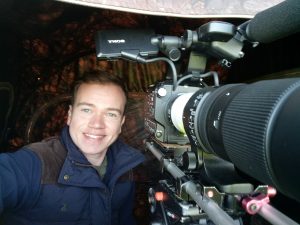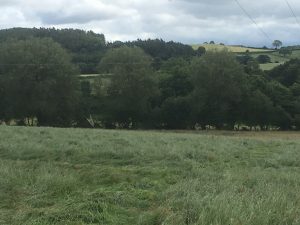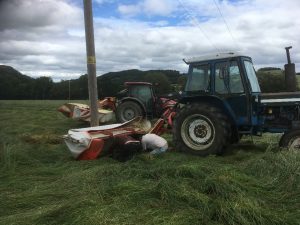Glamorous events – Habberley
A snapshot of the Life of the Project Manager, Amanda Perkins
This blog was started a few weeks ago but has taken until now to complete as ‘other events’ have intervened.

Saturday 6th July
It’s been a glamorous few days. On Saturday Billy Clapham, the fantastic young film-maker from Bristol, came to give a talk at Habberley Village Hall. Bill made a film about farmers and curlew called the Keeper of the Call while working with our project last year. He was a Masters’ student at West of England University which is linked to the BBC wildlife unit. Based on the quality of his work in this short production, Bill was offered an interview with Winter Watch and got the job. It was exciting for all of us when he was asked to edit his film and show it on Spring Watch in three short pieces, which was eventually reduced to 2 pieces. Bill was asked to share his experiences of making the film and his other work at the Habberley event.
Curlew Country volunteer, Siobhan Reedy, organised a team and sponsored the event, helped by fellow volunteer Janet Radford. The provision of delicious cheese and wine prompted several enquiries about the suppliers. It was a fantastic success and in the end the organisers were letting people in only if they could find a seat. Local wildlife photographer John Crook nearly outshone Billy, showing beautiful pictures and films of wildlife on and around his home near the Habberley Brook and injecting a touch of humour.
Bill stayed with our family often during the making of his film and it was a treat to have him back in his Shropshire base for a night. Wynford and Joyce Jones who own the farm which was the centre of Bill’s story, became great friends with him during the filming process. They followed Bill and I home with Rosie and Anna from WWT for some late socialising and catching up.
Sunday 7th July

Habberley is a fantastic community and one which strives to care for what is likely to be its only remaining pair of curlews. Regrettably this pair, like the majority, have not had much luck. Last year they were found by Gareth the dairy farmer as he was mowing. The Curlew Country team could not get to the nest to put up a protective electric fence in time (we cannot be everywhere at once in the high season), and by the following day the nest had been predated. Gareth was fed up and disappointed (although I don’t think that’s exactly as he phrased it). This year we gave him a fence to hold in case of a similar emergency, but they were not found on his land. This curlew pair is particularly elusive and quiet. Heard by volunteers, bird surveyors and farmers early in the season, they were not discovered again until much later. Then a bout of daily sightings by farmer Steve (Titch) Williams while moving the electric fence for his cattle, was followed by a period of a week or so of no evidence.
 Barry, the farmer on whose land they have settled this year, was keen to cut his field but also to save the curlews and was advised that it was safe to do so as the birds had not recently been sighted. Just as this had happened, the curlew family were heard and seen again. On my initial visit to try and find the birds earlier in the week I was surprised to find others there and a party atmosphere with beer and cheesecake supplied. A hide had been set up consisting of a deckchair on the cab of a tractor (not as bad as it sounds) and those present were taking it in turns to keep a lookout. On Sunday fatigued by all their efforts the night before, the keen Habberley volunteer team of bird surveyors and farmers met up to work out what might be done to try and save ‘their’ curlew family.
Barry, the farmer on whose land they have settled this year, was keen to cut his field but also to save the curlews and was advised that it was safe to do so as the birds had not recently been sighted. Just as this had happened, the curlew family were heard and seen again. On my initial visit to try and find the birds earlier in the week I was surprised to find others there and a party atmosphere with beer and cheesecake supplied. A hide had been set up consisting of a deckchair on the cab of a tractor (not as bad as it sounds) and those present were taking it in turns to keep a lookout. On Sunday fatigued by all their efforts the night before, the keen Habberley volunteer team of bird surveyors and farmers met up to work out what might be done to try and save ‘their’ curlew family.
Tony Cross, the ornithologist and I went to consider how we might save the chick or chicks on Sunday evening. As the chicks are not radio tagged it was difficult to locate them in a thick sward. We spotted the male (it was likely that the female had already set off on migration) and at least one chick. We both thought that we had heard another in a different part of the field. This led to more messages back and forth with the Habberley curlew volunteers and a plan being formed which was weather and contractor dependent.
Monday 8th July
Up at 4.40am to catch a train to London. Tony Cross and I were part of a group of 22 to be invited to a curlew summit at No. 10 Downing Street. The summit was organised by Lord Randall the PM’s environment advisor with much help from Curlew Ambassador, Mary Colwell Hector. (More about this in the next blog).
Wednesday 10th July
The ornithologist, his nightjar monitoring assistant and I went to try and rescue the curlews at Habberley. Another local farmer Tony Jones, key curlew spotter, had constructed a high seat, lent by local shoot manager Ivan, in a secret location on neighbouring farmer Steve’s land. This allowing him to keep an eye on these birds and get a better chance of finding them when cutting time arrived. He, Steve, and Titch’s neighbour Jimmy (who had recently been recruited and given our curlew observation video to help with behavioural clues), had given us some good feedback on their movements. Tony arrived earlier than I and had tried unsuccessfully again to catch the birds and ring them. We then needed to get them back into an area of the field before the contractors arrived to cut the silage.

It is always a bit chaotic at silage harvesting time. The weather usually dictates that everything is to be done as quickly as possible and adding to that pressure is the short window of time available to get everything done on a number of farms. There was a fleet of vehicles and an army of operators at the farm. Another contractor was coming to cut the crop.
We tried through a variety of methods to move the curlew family (male and two chicks) into an area of wet grassland at the bottom of the field. Barry the farmer had kindly offered not to cut this bit of the field until the chicks had fledged. To save the additional costs of getting contractors to return to the farm, Tony and Titch had offered to mow and bale the field when the birds had gone. The impromptu ‘curlew protection squad’ (or CPS for short) walked, used the vehicle and sat still in their attempts to direct the birds. It was trial and error as the adult tried to distract us and call the chicks away from the wet patch. We became despondent at times that our second guessing was failing.
On the arrival of the contractor, I discussed with him our plan and thoughts on a mowing sequence, but this did not quite resonate. There was an alarming moment when both Tony and I leapt out of the vehicle and started screaming and shouting and running toward the mower operating, where we had last seen the chicks. Not long afterwards, the contractor’s mower became unable to cope with the density of the sward. Tony and Titch were called to the rescue with their two different mowers, super keen to do all that they could to give the curlews a chance. They agreed a plan and kept consulting with Tony and me whilst we kept an eye on the movements of the family, which thankfully confined itself to the wet patch. The strip mown by the original contractor helped to prevent them from crossing an open patch into the commotion of harvesting, although it was a risky and heart-stopping moment when it was mown.

Mowing of the surrounding fields drew in numbers of buzzards, kites and gulls and the ‘CPS’ cringed and swore as they flew over scouting for the chicks, whilst the adult alarm called. One determined buzzard kept taking up well disguised perches in the oak above their preferred foraging area. Tony noticed that the curlew male was only defending the chicks against this and other buzzards and not bothering with the kites who seemed menacing. We assumed that the chicks were now of sufficient size and weight to prevent their predation by a kite and that the curlew’s instincts were in tune with this. The species rich wet patch was less dense than the main silage crop and provided less cover, but the chicks were still managing to hide reasonably well. Through our binoculars we could see a cloud of invertebrates above the crop, even before mowing started. Both adult and chicks seemed to have a good food supply and adequate cover to stop them from wandering too far out of the field.
After the mowing came the forage harvesting. However, word came back from the farm that the silage clamp was full1*. It became unclear whether the crop would be taken or left in the field and Tony kindly volunteered to sit things out to ensure that the curlew family stayed safe. I returned to my desk.
Two weeks later
I had explained to all volunteers that even with all the effort and goodwill that had gone into trying to  save these birds that we might not succeed. Another week passed with the birds being monitored. This week, the volunteers have reported that all are gone, having seen them flying in the previous days but also causing concern at their vulnerability when foraging out in the open areas from which the grass had been cut and taken. We are all hoping that gone means successfully fledged. There is similar news of another curlew family sticking to similar habitat in an area where predation control is active, and there may be more yet.
save these birds that we might not succeed. Another week passed with the birds being monitored. This week, the volunteers have reported that all are gone, having seen them flying in the previous days but also causing concern at their vulnerability when foraging out in the open areas from which the grass had been cut and taken. We are all hoping that gone means successfully fledged. There is similar news of another curlew family sticking to similar habitat in an area where predation control is active, and there may be more yet.
HURRAH FOR HABBERLEY
The Habberley community has given a curlew family in a natural nest the best chance of enabling chicks to fledge. We are so grateful to all who played a part in this curlew rescue mission. From the farmer who sacrificed a wet bit of ground with a species-rich sward, saving essential curlew habitat and enabling the chicks to fledge.2* The volunteer bird surveyors out searching for the curlew to try and help save them. The group of farmers also keeping watch, reporting back quickly and making all efforts to plan and volunteer their services. The neighbouring shoot which lent the high seat. Jimmy in the bungalow near to the nest site who got roped into help. And finally to those in Habberley who have helped support our funding effort, not least those who arranged the recent event which raised a fantastic £1,000.
In the next blog I will write about the trip to No. 10 Downing Street. One of our key messages is that conservation is about people. This fabulous community demonstrates so well what can be done when the right people come together to work constructively, which is the bit that often seems to be missing in planned projects. My plea to the policy makers is not to miss the opportunity to galvanise the goodwill of those people. Instead, use it to ensure that the sum of these ‘wholes’ becomes much bigger than the failing conservation of the individual parts. Where groups like this have been established and are working effectively and using the model to create similar groups (including among the many enquiries we get from people wanting us to help them) there is a ‘headstart’.
1* Last year the shortage of grass for hay and silage meant that the price was @£40 per big bale. This year there is an abundant crop and the weather was good at mowing time, so winter forage should be plentiful and cheaper.
2* Curlew Country has worked with a farm business manager to establish the real costs to farmers of supporting breeding curlews. The current agri-environment schemes are not adequate. Farmers can in good years afford to ‘go the extra mile’ as Barry did this year, but we have found that this act of generosity is not sustainable for the farm business over a number of years.

